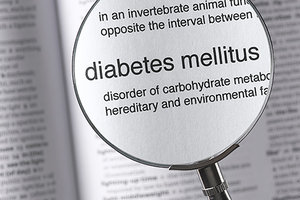Diabetes is recognized as one of the top chronic illnesses plaguing our society today. Statistics on the prevalence of diagnosed and undiagnosed diabetes (see below) make this point crystal clear.1 Based on these statistics, one-third of the American population has diabetes and almost one-third of that group hasn't been diagnosed yet.
Quick Stats: Scope of the Problem
- An estimated 30.3 million people of all ages (9.4 percent of the U.S. population) had diabetes as of 2015.
- This total included 30.2 million adults ages 18 years or older (12.2 percent of all U.S. adults), of which 7.2 million (23.8 percent) were not aware of or did not report having diabetes.
- The percentage of adults with diabetes increased with age, reaching a high of 25.2 percent among adults ages 65 years or older.
- Compared to non-Hispanic whites, the age-adjusted prevalence of diagnosed and undiagnosed diabetes was higher among Asians, non-Hispanic blacks and Hispanics from 2011–2014.
Causes and Solutions
We can look to food / chemical sensitivities and lifestyle choices for both causes and solutions. What comes first, the sugar or the insulin? The body is designed to break down sugar, send it to the bloodstream to be met by insulin, and be chaperoned into the cell for storage or energy. When the body is overloaded with sugar, insulin loses its ability to be effective. Eating a diet high in processed sugar and low in fiber sets the system up for failure.
 Got milk? Avoiding cow dairy has been associated with reduced risk of insulin resistance and metabolic syndrome.2 Cow dairy has also been associated with an increase in type 1 diabetes.3 It's not new information that food / chemical tolerance is both clinically important and patient specific. Dr. R. Jaffe and colleagues suggest that by reducing the effects of the immunological load, removing excess and damaging toxins, and restoring patient-specific nutrients, glycemic control can be improved.4
Got milk? Avoiding cow dairy has been associated with reduced risk of insulin resistance and metabolic syndrome.2 Cow dairy has also been associated with an increase in type 1 diabetes.3 It's not new information that food / chemical tolerance is both clinically important and patient specific. Dr. R. Jaffe and colleagues suggest that by reducing the effects of the immunological load, removing excess and damaging toxins, and restoring patient-specific nutrients, glycemic control can be improved.4
Educate Patients: 5 Steps to Reverse Type 2 Diabetes
When first diagnosed, patients can feel overwhelmed and confused by all of the information provided by "Dr. Google." Let's simplify things: Type 2 diabetes may be completely reversible.5 The LRA by ELISA/ACT food / chemical sensitivity test will identify triggers of the immune system. Avoid the sensitivities and help patients with lifestyle education using these five steps:
- Cut the sugar. We must help the patient understand the food / lifestyle choices that set the insulin resistance ball in motion. More insulin is not what the body needs. A diet without refined sugar is a great place to start.
- Exercise. Anyone with a high-sugar diet can be at risk for type 2 diabetes. Being overweight puts you at higher risk. Begin a simple exercise routine, even if that means taking the dog for a 20-minute walk each day.
- Eat more fiber. When you consume fiber, it slows the release of sugar into the bloodstream. Fiber can be found in dark leafy greens, berries, legumes, nuts and seeds.
- Start the day with protein. Encourage a better blood sugar balance by avoiding starchy carbs for breakfast. Cortisol's job is to break down sugars to provide energy and help balance blood sugar. Starting the day high in starchy carbs doesn't set this process up for success.
- Plan your meals. Be prepared! If there aren't sugar snacks and high sugar foods in the house, they won't be eaten. The same goes when you're at work or out and about. If you've planned appropriately the temptation to stop and grab something won't be as strong.
Anti-Diabetes Eating: An Example
Here is a simple recipe that achieves most of the nutritional suggestions above and will help get patients at risk for or suffering from diabetes on the right track:
Thai Veggie Salad (serves four)
- 1 red bell pepper sliced thinly, lengthwise
- 1 green bell pepper sliced thinly, lengthwise
- 1 medium cucumber, shredded
- 2 cloves garlic, minced
- 1 medium red onion, sliced thinly
- 2 medium zucchini, spiraled
- 1 carrot, shredded
- 1 small bundle cilantro, chopped (optional)
After prepping, put all veggies in a large bowl. Then prepare dressing:
Dressing
- 2 tbsp. peanut butter
- 2 pinches dried red-pepper flakes
- 2-4 tbsp. avocado (or olive) oil
Briskly stir oil and peanut butter until smooth. Sprinkle in pepper flakes. Toss veggies with dressing and top with cilantro. Add your choice of protein.
Address the Whole Person
In this practice, I [Dr. Briggs] feel it is necessary to address other aspects of the patient as a whole. Acupuncture is considered as an option to improve the flow of blood and qi, and facilitate systemic healing. There are many approaches to this and I have countless "recipes" in my library – as do you.
Often I will fall back to electronic meridian imaging as a way to evaluate the overall meridian system, identify imbalances and balance the overall system. I have found this clean, simple and very visual for the patient to understand what we are trying to accomplish. On follow-ups, I may then also treat condition-specific points to augment the ongoing healing process.
I will also pursue physical evaluation and of course, chiropractic care. As a chiropractic physician, I must recognize the mechanical component of a patient's overall well-being – if the underlying mechanics aren't right, then that puts everything else in a compromised state. Again, not every patient is treated with the same techniques or in the same spinal regions. I always ask myself, what does the particular individual need at this time to move them forward toward optimal health?
References
- National Diabetes Statistics Report, 2017: Estimates of Diabetes and Its Burden in the United States. Centers for Disease Control and Prevention, National Center for Chronic Disease Prevention and Health Promotion.
- Lawlor DA, et al. Avoiding milk is associated with a reduced risk of insulin resistance and the metabolic syndrome: findings from the British Women's Heart and Health Study. Diabet Med, 2005;22:808-811.
- Martin JM, et al. Milk proteins in the etiology of insulin dependent diabetes mellitus (IDDM). Ann Med, 1991;23:447-452.
- Jaffe R, et al. Tolerance loss in diabetics: association with foreign antigen exposure (letter to the editor). Diabet Med, 2005;23:924-28.
- "Is Type 2 Diabetes Reversible?" American Diabetes Association, reporting on a study in Diabetes Care, 2016;39:808-15.
Click here for more information about Douglas R. Briggs, DC, Dipl. Ac. (IAMA), DAAPM, EMT.
Melissa Crispell is a certified nutrition specialist, certified wellness coach, certified natural healthcare practitioner, friend of First State Health & Wellness and nationally-recognized speaker.





